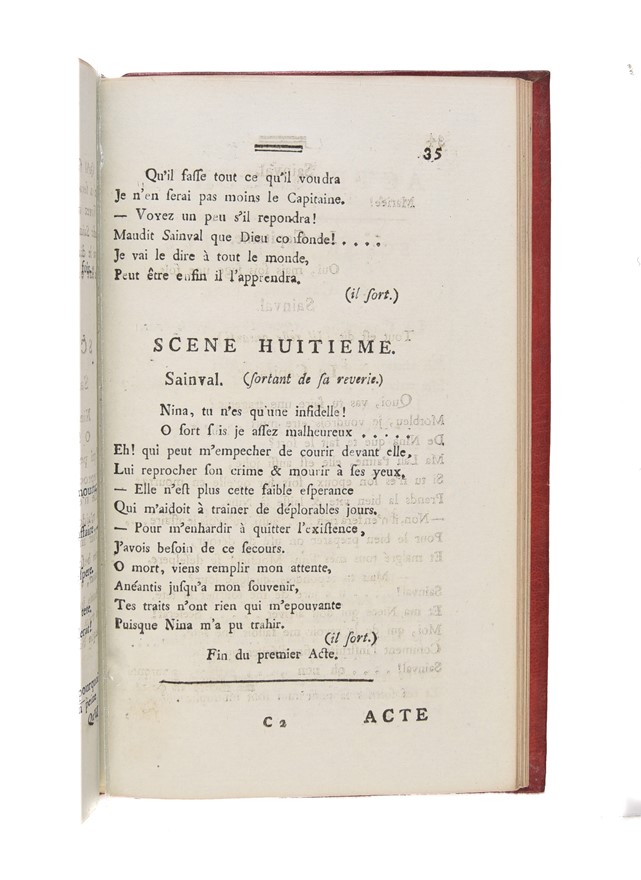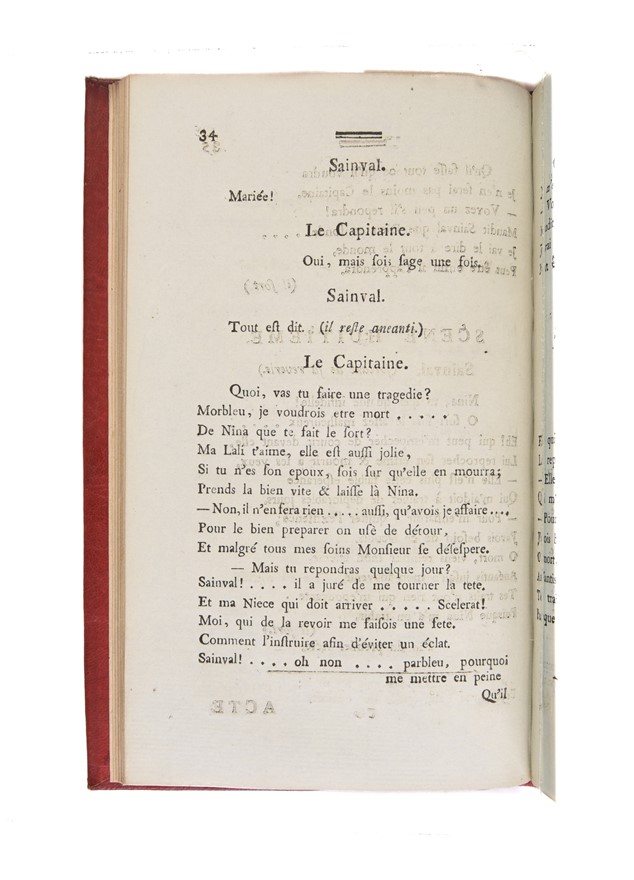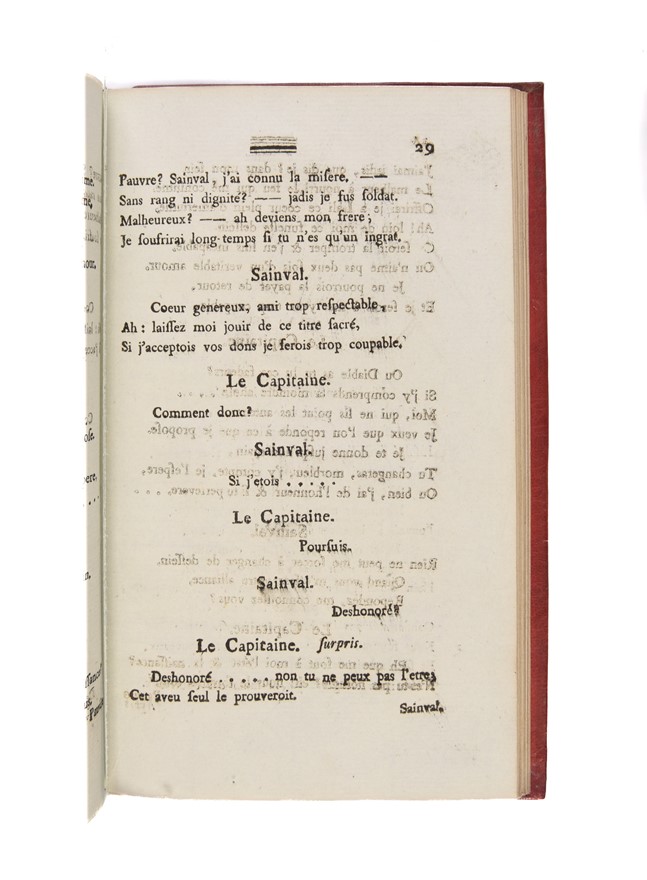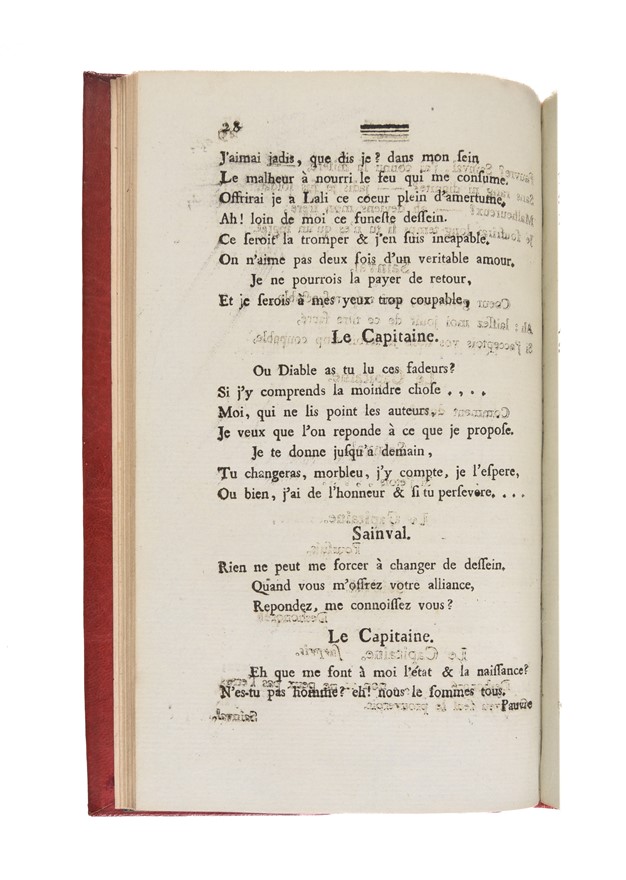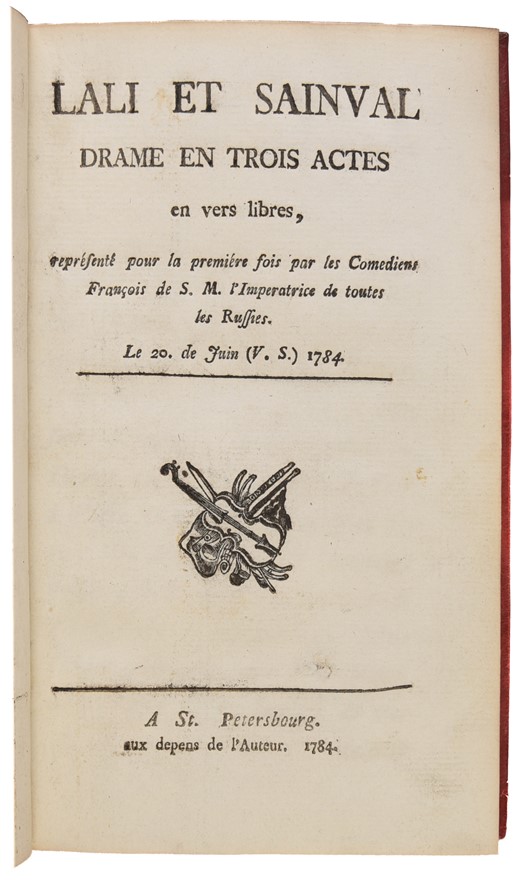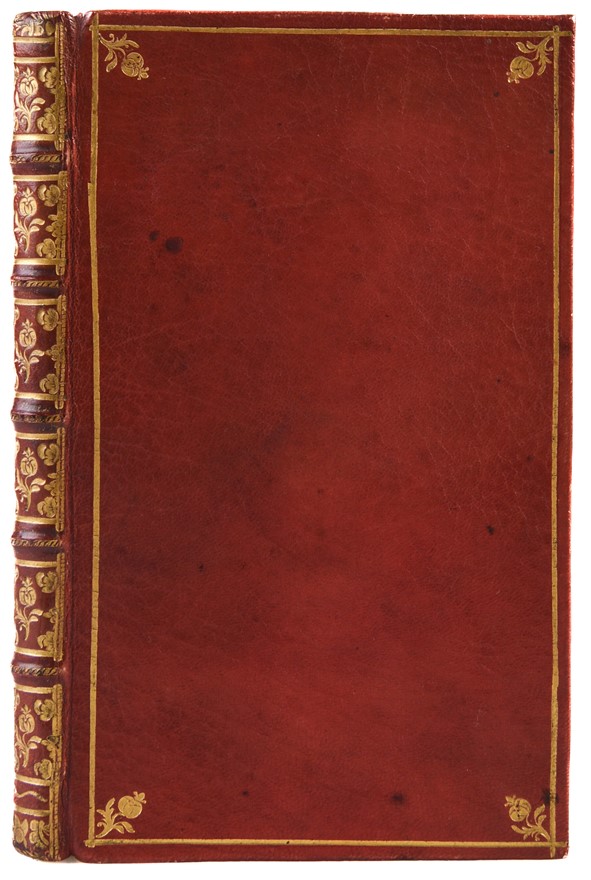Lali et Sainval drame en trois actes en vers libres, représenté pour la premieré fois par les Comediens François de S. M . l'Imperatrice de toutes les Russies. Le 20 de Juin
BARON L'ESTAT (1784)
£12500.00
Please contact us in advance if you would like to view this book at our Curzon Street shop.
WRITTEN & PERFORMED FOR CATHERINE THE GREAT
Title with woodcut vignette of musical instruments.
8vo. [4], 75pp. Eighteenth-century red morocco, simple gilt fillet and floral cornerpieces, spine gilt in compartments, a.e.g.
St. Petersbourg, aux dépens de l'Auteur,
The extremely rare, sole edition of this play in print, written and performed just once for Catherine the Great, handsomely printed and likely bound in St Petersburg in 1784. An impressive survival in exceptional condition of an artefact of the cultural francophilia of the Russian imperial court in this period. We have traced no other copies in institutions outside Russia.
Written by playwright and French attaché to the Empress’ cabinet, Baron D’Estat, and inspired, as he writes in his Avis aux lectures, by a popular romance, the present play was performed by the French troupe at the Empress’ court in St Petersburg on 20 June, 1784. This permanent troupe –made up of actors invited by the Russian court from all over German and French territories – was established under empress Elisabeth and had their first performance in 1743. By Catherine’s rule they cost the Russian court twice as much as the Russian equivalent (Evstratov, p.50), testament to the established ‘cultural and linguistic Gallicization’ of the Russian court that had begun under Catherine’s predecessors and that the Empress continued in earnest. ‘French theatre was at the heart of Catherine’s theatrical and political projects’ (Evstratov, p.15); her trust in the ‘civilising’ function of theatre itself as ‘l’école du peuple’ (Ponzetto, 82) is borne out in listings of French-language plays at her court between 1762 and 1796. They reveal the sheer frequency and variety of such performances, including dramas such as the present work, comedies (Catherine’s particular favourites), opera, ballet, and theatre ‘en pierre’, masques.
This play was performed just once at Catherine’s court and its author is little-known, which makes the survival of this volume all the more remarkable. In his study of French theatre at the Russian court in this period, Alexei Evstratov writes that French pieces and plays written expressly for Russian theatre were far less numerous than performances of plays originally written for French audiences and imported from France. Within that already small group, Evstratov distinguishes between those written by individuals who worked professionally for the theatre, and occasional writers with no other theatrical connection; in turn, of those twentyfive pieces, only nine plays performed were written by foreign diplomats, a group which includes D’Estat as French attaché to the cabinet (Evstratov, p.144).
D’Estat was known to Catherine the Great; in honour of the completion of the construction of Catherine’s Theatre de l’Hermitage at the Winter Court in 1785, just a year after the present work was performed and printed, a collection was published of pieces written specifically to be performed there. Printed in an extremely small run ‘as a sort of plaquette souvenir’ (Ponzetto, 85), the Recueil des pieces de l’Hermitage (4 vol., St Petersburg: typographie de l’Ecole des Mines, 1788) contained several short pieces composed by a small group that included Catherine herself, several Russian and Austrian dignitaries, and d’Estat, one of only two French contributors (his pieces in the third volume; Ponzetto, 85).
He was, briefly, the subject of a letter from the Empress in 1792 in which she mentions this contribution and touches on his career [our translation]: ‘I already knew what you told me about D’Estat; he came from the vast poultry yard of Prince Potemkin; from there he entered the service of the Prince of Nassau, and gained access to the theatre de l’Hermitage because he wrote proverbes dramatiques [short comedic pieces based on a proverb]; he never went beyond the theatre; he went to Paris under the pretext of poor health; his comments in Warsaw and Paris saw him removed from the [presumably diplomatic] service and he lost his pension’ (letter dated Aug. 13th, 1792, cited in Bil’basov, pp.393-4, no.453). His name is attached to only a few dramatic works; alongside the proverbes submitted to the Recueil and the present drama, is La prise d’Ochakoff, dedie aux Russes (1789), celebrating Potemkin’s siege and capture of the city of Ochakov in 1788 during the Russo-Turkish war.
The prevalence of French cultural influence and input in eighteenth-century St Petersburg extended to the trades, including typesetting, printing and bookbinding. An easing of press restrictions in Russia under Catherine in 1783 encouraged the entrance of many new groups into the printing trade, the majority of whom were non-Russian (Marker, p.105-110).A Gallic influence is clear in the physical properties of this volume, as early as the woodcut device on the title page – ‘these ornamental designs, known as vignettes, were likely obtained through German intermediaries, but the borrowed rococo style betrays their French origin’ (Coker, p.289). There is an appealing crudeness and naivety to the printing and binding that distinguish it from French book production in this period; there is consistent offsetting between facing pages throughout the volume in a way that indicate that the sheets were bound - or at the very least sewn and pressed - while the ink was still wet. The binding shows a strong French influence, yet the simple gilt fillet on the upper and lower boards is uneven and a little crooked in places.
The present work, L’Estat explains in his preface, is adapted from Les derniers aventures du jeune d’Olban, a popular novel by Louis Ramond de Carbonnières, published only a few years earlier; L’Estat explains that he is little more than a humble editor of the original text, with the principal difference being that he has rewritten this play in verse.
Some offsetting, otherwise a lovely copy in excellent condition.
Provenance: Small ‘Printed in Russia’ import stamp in purple ink on front free endpaper (see comparable examples in volumes from the Russian Imperial Collection at the LOC). V. A. Bil’basov, Katharina II, Kaiserin von Russland im Urtheile der Weltliteratur (Berlin: 1897), no. 453. Refs: A. N. Coker, French Influences in Russia 1780s-1820s: The Origins of Permanent Cultural Transfer (unpubl. PhD thesis, University of Exeter, 2015). A. Evstratov, ‘Liste chronologique des spectacles joués en français en russie (1762-1796)’, appendix to unpublished thesis [open access]; Evstratov, Les Spectacles francophones à la cour de Russie (1743–1796) (Oxford: 2016). D. Offord et al., The French Language in Russia (Amsterdam: 2018). V. Ponzetto, ‘Theatre de l’Hermitage: des proverbes dramatiques en francais pour la cour de Catherine II de Russie”, in La Scène en version originale ed. Julie Vatain-Corfdir (Paris: PUPS 2015), pp.81-100.
Stock Code: 248325
